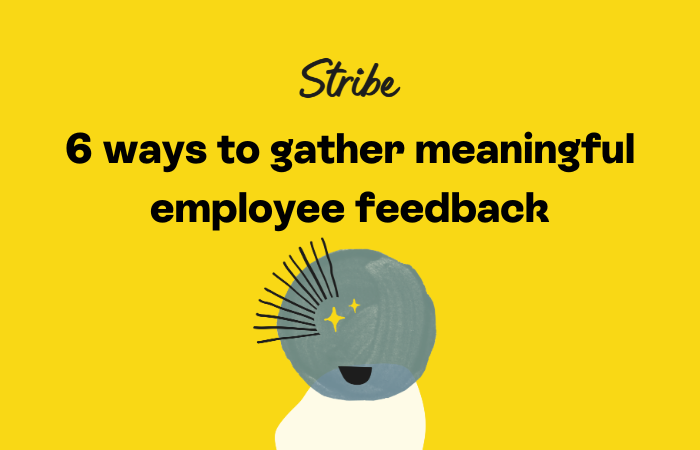
Most leaders know that employee feedback is essential for a successful and thriving workplace. It provides valuable insights into how employees are feeling about their roles, their managers, the challenges they experience day-to-day – and more importantly – creates the conversations needed to find solutions.
Feedback can truly be the lifeblood of an organisation if it’s gathered meaningfully – improving satisfaction, morale and productivity of your team. The trick is, however, is to ensure you’re receiving meaningful feedback – that’s honest, authentic, and actionable. But that can only be achieved by building a foundation of trust.
In this article we give you 6 proven tips that are going to help you build transparency and confidence within your team, so they are comfortable in providing genuine feedback.
Anonymity first and foremost
Whichever way you decide to gather your feedback, your priority should be to make the channel anonymous, so your employees feel empowered to share their thoughts and opinions freely.
It’s no secret that many people feel anxiety or embarrassment when it comes to sharing how they deeply feel, or struggles they’ve had at work – anonymity is the answer to helping your team speak up. Creating a safe and non-judgmental space is crucial for encouraging meaningful feedback and helping keep your employee’s identities confidential is the first step.
At Stribe, we’ve work together with employees and HR teams to get a balance with the way we manage anonymity. Our system is fully anonymous, and only the employee will ever be able to reveal their own identity.
Pulse surveys are your friend!
Pulse surveys are going to be your best friend when it comes to gathering meaningful feedback from your team. This is because they tick all the boxes – anonymous, frequent, and targeted.
Pulse surveys are designed to consist of short, focused questionnaires that are sent out to teams at regular intervals to capture real-time insights. What’s brilliant about them is they allow you to stay connected with your employees and promptly address any emerging issues – rather than later down the line when employees may feel it’s too late to address any concerns or questions.
The succinct format of pulse surveys makes them easily digestible and encourages higher response rates. You can track trends, monitor employee satisfaction, assess the impact of initiatives, and identify areas for improvement in a super timely manner.
Even better – we know from organisational case studies from teams who have used pulse surveys before – that the frequent feedback loop created by pulse surveys encourages a culture of ongoing improvement and employees really appreciate that their opinions are being heard.
Safety and trust are paramount
Like any relationship trust is the foundation. Without it, it’s going to be difficult to gain meaningful insights from your team.
Employees often have super valuable insights and innovative ideas that can really enhance the workplace. But unfortunately, a lack of trust between employers and employees often hinders the open sharing of honest feedback, as employees fear potential repercussions.
To overcome this challenge, you will need to lead by example. As a leader, openly share your own thoughts and encourage others to follow suit. By demonstrating your willingness to accept and act on feedback, you will show your team they can feel safe doing the same.
It’s also often a great idea to establish a system where a trusted third party (or employee engagement software like ours here at Stribe) collects feedback from employees. By having a trusted intermediary involved, it creates a sense of security and confidentiality, which will help your team express their opinions without reservation.
Talk about challenges
It’s no doubt that when you are creating questionnaires and meeting with your teams for candid conversations, you’ll have an array of questions. But you want to select questions that really create space for opening -up how your team is feeling, and how they believe things can be improved.
One of the best questions to ask is – “What are your top three challenges, and what are your suggestions or recommendations to overcome these?”
This kind of questions allows you to gather viewpoints (and solutions) from different people at different levels in your organisation, which goes a long way in understanding the bigger picture. You’ll also build rapport with your people for allowing them the space to speak up about the issues that are affecting them directly.
And, talk about aspirations!
It’s one thing to talk about the negatives, but don’t forget about the positives too! Ask the people at your organisation about their big ideas, their dreams, and aspirations.
You can ask – “What can we do to make your role as close to your ideal situation as possible?”
You’ll allow your people to be creative and communicate what they really want and desire, which will uncover what really motivates them. Your team will appreciate that you’re willing to really hear them when it comes to improving their role and overall satisfaction at work.
Act on the answers
Last but certainly not least – in fact, arguably the most important step – is to act. Once you’ve gathered feedback, it’s essential to come up with an action plan and share this with your team.
Employees need to see that their feedback is valued and that their concerns are being heard. By taking action on feedback, you can be sure that you’ll build rapport within your team so that the next time there’s an employee survey, or any opportunity to speak up – they will be honest and meaningful with their feelings and thoughts.
When people are heard, teams are happy!
To learn more about Stribe and how our employee engagement platform can help your team be the best they can be – get in touch today.